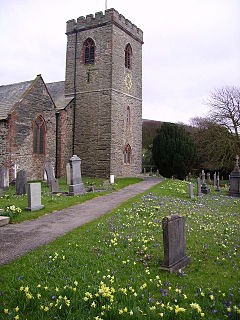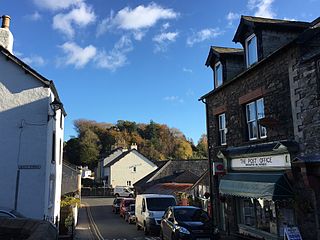Related Research Articles

Millom is a town and civil parish on the north shore of the estuary of the River Duddon in southwest Cumbria, historically part of Cumberland, England. It is situated just outside the Lake District National Park, about six miles north of Barrow-in-Furness and 26 mi (42 km) south of Whitehaven.

Hardknott Pass is a hill pass between Eskdale and the Duddon Valley in the Lake District National Park, Cumbria, England. The tarmac-surfaced road, which is the most direct route from the central Lake District to West Cumbria, shares the title of steepest road in England with Rosedale Chimney Bank in North Yorkshire. It has a maximum gradient of 1 in 3.

The Duddon Valley is a valley in the Lake District National Park in Cumbria, England. The River Duddon flows through the valley, rising in the mountains between Eskdale and Langdale, before flowing into the Irish Sea near Broughton in Furness. In its lower reaches it is bounded by the Furness Fells and Harter Fell.

Cold Pike is a fell in the English Lake District. It is a satellite of Crinkle Crags and stands above the Upper Duddon Valley.

Whitfell is a hill of 573 metres (1,880 ft) in the southwestern part of the Lake District. It is the highest point between Black Combe and Harter Fell on the broad ridge to the west of the Duddon Valley. Views from the summit include the full length of the Duddon Valley including its estuary; the western side of the Coniston fells; the Eskdale fells including Scafell and Bowfell; much of western Cumbria including the estuary of the Rivers Esk, Mite and Irt; the Isle of Man; as well as the hills to the south culminating in Black Combe.

The Duddon is a river of north-west England. It rises at a point 1,289 feet (393 m) above sea level near the Three Shire Stone at the highest point of Wrynose Pass. The river descends to the sea over a course of about 15 miles (24 km) before entering the Irish Sea at the Duddon Sands. In total, from source to the westernmost part of Duddon Sands, its length is 43 kilometres (27 mi). For its entire length the Duddon forms the boundary between the historic counties of Lancashire and Cumberland and since local government re-organisation in 1974 the Duddon has been in the ceremonial county of Cumbria.

Hardknott Roman Fort is an archeological site, the remains of the Roman fort Mediobogdum, located on the western side of the Hardknott Pass in the English county of Cumbria. The fort was built between 120 and 138 on a rocky spur, and was initially garrisoned by a detachment of the Cohors IV Delmatarum from the Dalmatian coast. It was abandoned around a decade later, then reoccupied circa 200 and remained in use for much of the next two centuries.

Pike of Blisco, or Pike o' Blisco, is a mountain in the Lake District in Cumbria, England. Located between the valleys of Great Langdale and Little Langdale, its relative isolation from neighbouring fells together with slopes falling away immediately from the summit in all directions mean it has excellent views: the view of the Langdale Pikes across Great Langdale is particularly arresting.

Kirkby-in-Furness, generally referred to simply as Kirkby locally, is a village in the Furness area of Cumbria, England. Historically part of Lancashire, it's located close to the Lake District National Park. It is about 3 miles (5 km) south of Broughton in Furness, 5 miles (8 km) northwest of Ulverston and 9 miles (14 km) north of Barrow-in-Furness. It is one of the largest villages on the peninsula's north-western coast, looking out over the Duddon estuary. In 2019 it had an estimated population of 563.

Broughton in Furness is a market town in the civil parish of Broughton West in the South Lakeland district of Cumbria, England. It had a population of 529 at the 2011 Census. It is located on the south western boundary of England's Lake District National Park in the Furness region of Cumbria, which was originally part of Lancashire before 1974.
Josefina Alys Hermes de Vasconcellos was an English sculptor who worked in bronze, stone, wood, lead and perspex. She was at one time the world's oldest living sculptor. She lived in Cumbria much of her working life. Her most famous work includes Reconciliation ; Holy Family ; Mary and Child ; and Nativity at St. Martin-in-the-Fields.

Ulpha is a small village and civil parish in the Duddon Valley in the Lake District National Park in Cumbria, England. Historically in Cumberland, it forms part of the borough of Copeland. At Ulpha a road leaves the Duddon Valley to cross Birker Fell to the valley of Eskdale. In the 2001 census the parish had a population of 159, reducing at the 2011 Census to 128.

Thwaites is a small village near Duddon Valley and on the edge of the Duddon Estuary in the Lake District National Park in Cumbria, England. The River Duddon flows through the valley, rising in the mountains between Eskdale and Langdale, before flowing into the Irish Sea near Broughton in Furness. In its lower reaches it is bounded by the Furness Fells and Harter Fell.

Hodbarrow RSPB Reserve is a nature reserve run by the Royal Society for the Protection of Birds on the edge of the Lake District National Park in Cumbria, England. It is on the Duddon Estuary near the town of Millom.

Green Crag is a fell in the English Lake District. It stands between Eskdale and the Duddon valley in the Southern Fells.
Burnmoor may refer to:

Askam and Ireleth is a civil parish close to Barrow-in-Furness in the county of Cumbria, in North West England. Historically part of Lancashire, it originally consisted of two separate coastal villages with different origins and histories which, in recent times, have merged to become one continuous settlement. In the 2001 census the parish had a population of 3,632, reducing at the 2011 census to 3,462.

Seathwaite is a village in the Duddon Valley in the South Lakeland district of Cumbria in North West England. Historically in Lancashire, it lies within the Lake District National Park, and is part of the civil parish of Dunnerdale-with-Seathwaite, which has a population of 129. The nearby Seathwaite Tarn, west of the Coniston Fells, takes its name from the village. The village is north east of Hall Dunnerdale and south west of the tarn. It lies along the old Walna Scar road, which can be reached from the A595 in the south, or from the steep Hardknott–Wrynose pass road in the north, which leads off the A593 from Skelwith Bridge).

Birks Bridge is a traditional stone-built bridge over the River Duddon in the English Lake District, in Dunnerdale-with-Seathwaite, Cumbria, standing at Grid Reference SD239995.
References
- 1 2 Ring Cairns and Reservoirs: Archaeological Discoveries in the Duddon Valley, Cumbria, Stramongate Press Ltd: Kendal, (2009), pp. 44–46.
- ↑ Garner, Lawrence (2005). Dry Stone Walls. Osprey Publishing. p. 22. ISBN 9780747806202.